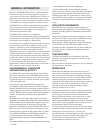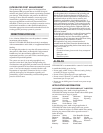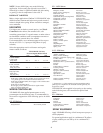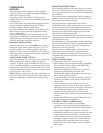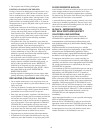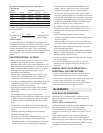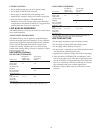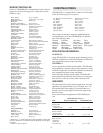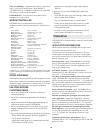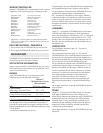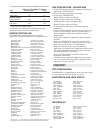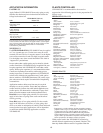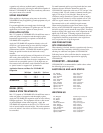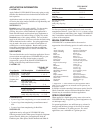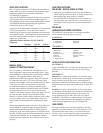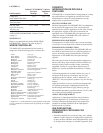
First year plantings - Transplant stock that is 2 years old or
more (1 year old for loblolly pine). Apply DuPont™
V
ELPAR® DF only if rainfall has settled the soil around the
base and root systems of the transplants.
Established trees - Trees that have been planted in the
p
lantation for 1 year or more.
WEEDS CONTROLLED
VELPAR® DF is recommended for the control or
suppression of the following weed species in Christmas tree
crops:
* Suppression – a visible reduction in plant population and/or plant
vigor as compared to an untreated area and generally not accepted
as control.
SPRAY EQUIPMENT
VELPAR® DF may be applied by ground equipment or by air.
Select a spray volume that will ensure a thorough and uniform
application. Apply a minimum of 5 gallons per acre by air and
a minimum of 10 gallons per acre by ground equipment.
USE PRECAUTIONS
CHRISTMAS TREES
•
Do not use
VELP
AR
®
DF in n
urseries, seed beds, or
ornamental plantings.
• Do not add a surfactant in applications over the top of
conifers.
•
W
eed control results from spring applications depend on
sufficient moisture to activate VELPAR® DF.
•
Do not cut tr
ea
ted v
e
g
etation for forage or hay nor graze
domestic animals on treated areas for 60 days following
a
pplica
tion.
• Poor weed and brush control may result from the following:
–Heavy duff or slash present at the time of application.
–Use on poorly drained sites.
–Applications made when soil is saturated with water and
rain is imminent within 24 hours.
–Applications to soils high in organic matter (greater
than 5%).
•
Injury may occur when VELPAR® DF is used on the
following:
–Trees that show poor vigor, insect damage, disease, winter
injury, or other stress conditions.
–Any soil containing less than 1% organic matter.
–
Loamy sand or sandy loam with less than 2% organic
matter (except Jeffrey Pine and Ponderosa Pine).
–Foliage after bud break.
–Gravelly or rocky soils, exposed subsoils, clay knobs,
sand, or sandy soil with 85% or more sand.
VELPAR® DF is recommended for control of certain weeds
in pineapple.
APPLICATION INFORMATION
Mix the proper amount of VELPAR® DF in water. Add a
surfactant at the rate of 0.25% V/V.
Use the lower rates on coarse-textured soils or in areas
where rainfall exceeds 65 inches per year. Use the higher
rates on fine-textured soils or in areas where rainfall is less
than 65 inches per year.
Intercrop period - Apply VELPAR® DF as a broadcast
spray in 100–400 gallons of water per acre at the rate of
1/3 - 2 1/3 pounds per acre. For aerial application, use at
least 10 gal water per acre.
Post mulch, preplant - Apply VELPAR® DF as a
broadcast spray in 100–400 gallons of water per acre at the
rate of 1/3 - 2 1/3 pounds per acre.
Post plant, before planted cuttings start active growth -
Apply VELPAR® DF as a broadcast spray in 100–400
gallons of water per acre at the rate of 1/3 - 2 1/3 pounds per
acre. A post-plant application should be made after planted
cuttings start to grow only when weed growth has escaped
control by other herbicide applications.
Prior to forcing first ratoon - Apply VELPAR® DF as a
br
oadcast spray in 100–400 gallons of water per acre at the
rate of 1/3 - 2 1/3 pounds per acre.
Dir
ected postemer
g
ence (pineapple and weeds) inter-
space application
- Apply VELPAR® DF as a directed
spray 3–10 months after planting in 50–200 gallons of water
per acr
e (br
oadcast basis) at the rate of 1/3 - 2 1/3 pounds
per acre (broadcast basis) using a stroller boom or knapsack.
Directed spot trea
tments f
or per
ennial grasses before
floral induction - Spray perennial grasses postemergence to
w
et (50–200 gallons per acre depending on size) with
1 1/3 - 2 1/3 pounds per 100 g
allons of w
a
ter as a spot
tr
ea
tment.
Treatments to field edges and roadsides - Apply
VELPAR® DF at 2 1/3 - 4 8/10 pounds per acre in 100–400
gallons of water.
PINEAPPLE
Aster, heath* Aster ericoides
Barnyardgrass Echinochloa crus-galli
Bentgrass, common Agrostis alba
Bluegrass, annual Poa annua
Bromegrass Bromus spp
Burnweed, American* Erechtites hieracifolius
Carrot, wild Daucus carota
Crabgrass* Digitaris spp
Curly dock* Rumex crispus
Daisy, oxeye Chrysanthemum leucanthemum
Dandelion, common* Taraxacum officinale
Dandelion, false*
(spotted catsear)
Hypochaeris radicata
Fescue* Festuca spp
Fleabane Conyza spp
Foxtail Setaria spp
Goldenrod* Solidago spp
Groundsel, common Senecio vulgaris
Horseweed/marestail Conyza canadensis
Orchardgrass * Dactylis glomerata
Ragweed, common Ambrosia elatior
Ryegrass, Italian (annual) Lolium multiflorum
Ryegrass, perennial* Lolium perenne
Smartweed, Pennsylvania Polygonum pensylvanicum
Velvetgrass, common Holcus lanatus
10



